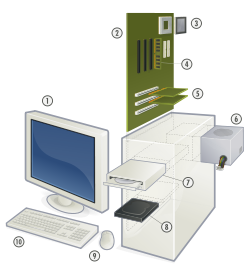Microcomputer

1. Monitor
2. Main board
3. Main processor
4. Main memory
5. Plug-in cards
6. Power supply unit
7. Optical drive
8. Hard disk
9. Computer mouse
10. Keyboard
Microcomputers (also called microcomputers ) are computers that are more compact than mainframes and mini computers and can be operated by a single person. Today the term is mostly associated with the first wave of 8-bit home and office computers.
In a narrower definition, it meant computers of a certain performance class that were less powerful than mainframes and mini-computers and only had a single microprocessor as the central unit . They have been used millions of times as home and office computers. The equipment was tailored to these applications.
The term workstation referred to versatile microcomputers for professional use, which were mostly easier to maintain, more reliable and significantly more powerful than home or office computers. They were mainly used in the technical-scientific field and were usually permanently integrated into a network.
In everyday language, the use of the term microcomputer has decreased significantly since the 1980s and is hardly common anymore, although an ever larger group of modern, microprocessor-controlled devices corresponds to the definition of a microcomputer. It has therefore largely been replaced by the term personal computer (PC) for desktop devices. With other designs, such. B. embedded systems , which are now characterized by an increased degree of integration of the components and a correspondingly compact design, the original term retains its validity.
literature
- Ludwig Graf, Helmut Jacob, Wolfgang Meindl, Wolfgang Weber: Do not be afraid of the microcomputer: advanced training course in the media association television - specialist book - seminars u. for d. Self-study. VDI-Verlag, Düsseldorf 1984, ISBN 3-18-400586-0 .
Web links
- Literature on microcomputers in the catalog of the German National Library